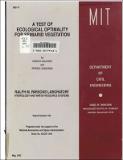A Test of Ecological Optimality for Semiarid Vegetation
Author(s)
Salvucci, Guido D.; Eagleson, Peter S.
Download26912193.pdf (6.472Mb)
Metadata
Show full item recordAbstract
Three ecological optimality hypotheses (Eagleson, 1978 and 1982) which have utility in parameter reduction and estimation in a climate-soil-vegetation water balance model are reviewed and tested. The first hypothesis involves short term optimization of vegetative canopy density through equilibrium soil moisture maximization. The second hypothesis involves vegetation type selection again through soil moisture maximization, and the third involves soil genesis through plant induced modification of soil hydraulic properties to values which result in a maximum rate of biomass productivity. The first hypothesis is found to be in excellent agreement with data observed at the Beaver Creek watershed in Central Arizona. The utility of this hypothesis in estimating soil properties is supported. The second hypothesis is found to be physically unrealistic and alternatives to the hypothesis are studied. Conditions at Beaver Creek are not appropriate for testing the third hypothesis. While the locus of canopy densities predicted by the short term ecological hypothesis creates a condition of stress free transpiration in typical years, lower than mean annual rainfall may still lead to drought-induced stress. In order to quantify this phenomenon, the expected value of the time spent in stress, and the resulting reduced transpiration, are analytically derived. The results of this analysis are shown to be useful in gaining a quantitative understanding of the water environment of semiarid regions and the drought tolerance required of its local vegetation.
Description
Prepared under the support of the National Aeronautics and Space Administration grant no. NAGW 1696
Date issued
1992-05Publisher
Cambridge, Mass. : Ralph M. Parsons Laboratory, Hydrology and Water Resource Systems, Massachusetts Institute of Technology, Dept. of Civil Engineering
Other identifiers
335
Series/Report no.
R (Massachusetts Institute of Technology. Department of Civil Engineering) ; 92-17.Report (Ralph M. Parsons Laboratory for Water Resources and Hydrodynamics) ; 335.